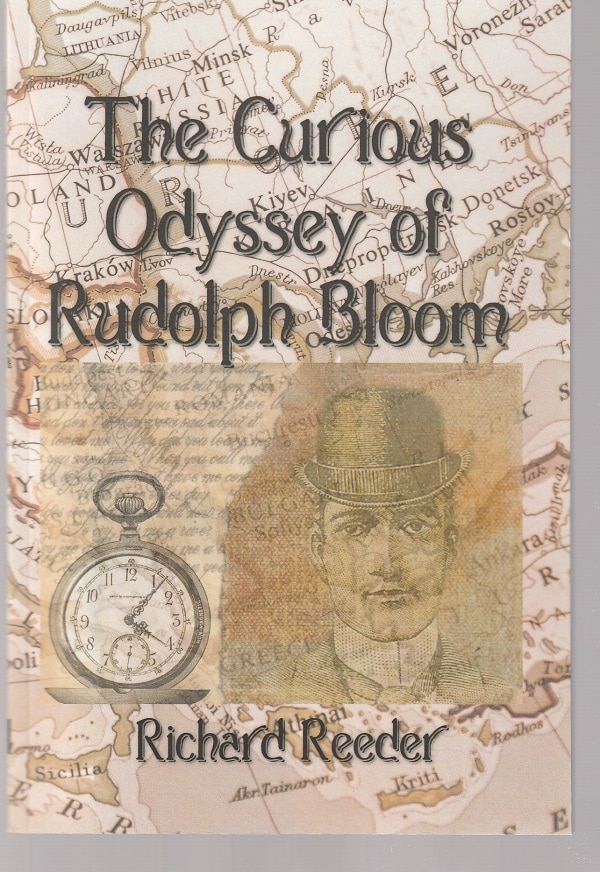The Curious Odyssey of Rudolph Bloom by Chicago writer Richard Reeder is a curious book, and not just because it owes its inspiration to that famous and famously challenging James Joyce novel Ulysses.
It’s also a curious book because, in its 104 pages, Reeder tells two complex stories — one about the discovery of the body of Rudolph Bloom, the father of Leopold, and the subsequent investigation of his apparent suicide, and the other contained in a manuscript he wrote that comes to be titled “The Curious Odyssey of Rudolph Bloom.”
So, Reeder’s book, in its odd way, is a miniscule prequel to Ulysses, telling the backstory of one of its most minor of characters. Indeed, this is a character who has been dead and buried 18 years by the time the action of Joyce’ novel takes place on the single ordinary day, June 16, 1904, now known as Bloomsday, and who gets only a handful of mentions here and there in the 730 pages of text.
That’s a lot of stuff to fit into the slimness of a novella, but it’s not all. A few days after Bloom’s suicide in 1886, his manuscript ends up in the hands of two legendary Irish writers — Bram Stoker, later the author of Dracula, and Oscar Wilde, later the author of The Picture of Dorian Gray and still later notorious for his homosexual relationship with an English Lord. Intrigued, Wilde revises the manuscript to give it a literary polish, and the two friends discuss the text.
Odysseys

Their conversations bracket Reeder’s presentation of Bloom’s story about the journey of his life, a journey in which he moves through many of the great cities of Europe and meets an amazing panoply of famous people, such as Karl Marx, Richard Wagner, Elizabeth Barrett Browning and Joseph Pulitzer.
I hope I’m making clear to you that, in Reeder’s novella, there’s a whole lot going on.
And, on top of that, there is this: Reeder has Bloom living and writing an odyssey which parallels the odyssey that, in the future, his son Leopold takes in Ulysses which parallels the travels, in the ancient past, of Odysseus (Ulysses in Latin) in Homer’s Odyssey.
And here’s the most curious part of all this — against all odds, Reeder’s novel works.
The Curious Odyssey of Rudolph Bloom is fun, interesting, engrossing, even captivating.
More than a bit of trepidation
I was glad to discover this because I started reading the novella with more than a bit of trepidation. The fact is that I know very little about Ulysses except that, as a work of literature, it’s pretty scary.
In my late 20s, I had a roommate who was a big fan of Joyce’s novel, but only because, as he read the book, he was simultaneously reading another one which, chapter by chapter, explained to him what was going on.
I was assured beforehand that I didn’t have to be a Ulysses expert in order to enjoy Reeder’s book, and that turned out to be true. The only thing I did before starting the book was to scan the summary of the novel’s plot at Wikipedia. That’s how I knew that Joyce was using the Odyssey as a framework and model.
Later, when I was nearly at the end of the book, I did some searching online to get a sense of how much Rudolph Bloom is mentioned in Joyce’s book — not much.
So, yeah, even though I was pretty much ignorant of Ulysses, I enjoyed The Curious Odyssey of Rudolph Bloom.
Fragments of Ulysses
However, I would bet that anyone who has read and gotten deep into Joyce’s novel will get even more out of reading Reeder’s book than I did.
For one thing, Reeder, who according to the author bio has taught the Joyce novel several times, fleshes out this minor minor character in a way that will probably resonate with a Ulysses fan. For another, Reeder borrows fragments of Ulysses for use in his novella.
For instance, after Bloom’s suicide, his friend Rev. Griffin recalls a discussion they had “in my study as we treated ourselves to a repast of Gogonzolla cheese and burgundy wine.” That rang a bell with me because I’d just read the Wikipedia entry which noted that, at one point during Bloomsday, Leopold Bloom goes to “Davy Byrne’s pub, where he consumes a gorgonzola cheese sandwich and a glass of burgundy, and muses upon the early days of his relationship with Molly…”
In another example, Bloom and his close friend Giuseppe Campoli, called Peppino, open their hotel in Florence on June 16, 1842 — 62 years before Bloomsday.
These are two borrowings that I happened to notice. I would imagine that there are more, maybe many more, that a Ulysses-phile would spot.
All of this, I find very curious. In a good way.
.
Patrick T. Reardon
3.22.22
Written by : Patrick T. Reardon
For more than three decades Patrick T. Reardon was an urban affairs writer, a feature writer, a columnist, and an editor for the Chicago Tribune. In 2000 he was one of a team of 50 staff members who won a Pulitzer Prize for explanatory reporting. Now a freelance writer and poet, he has contributed chapters to several books and is the author of Faith Stripped to Its Essence. His website is https://patricktreardon.com/.
